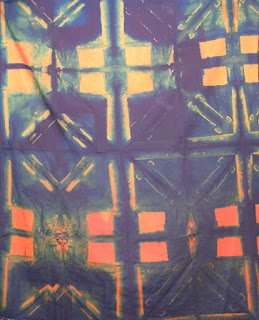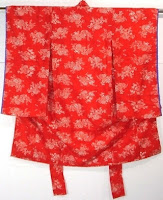Fabrics dyed in indigo by Elaine Blythe. These fabrics were first dyed and printed with various textile techniques, then over dyed with indigo. The indigo dye united the design and unifies the original colors .









Thursday, December 13, 2007
ITAJIME: Elaine Blythe
Posted by
M. JOAN LINTAULT
at
2:35 PM
0
comments
![]()
Wednesday, November 28, 2007
Saturday, November 17, 2007
ITAJIME FABRIC
Itajime, Kyokechi or clamped resist dyed fabric from the Shōsōin treasure house, Nara Period (710-794). Shōsōin (正倉院) is the treasure house that belongs to Tōdai-ji, Nara, Japan.





Posted by
M. JOAN LINTAULT
at
12:38 AM
0
comments
![]()
Sunday, November 04, 2007
ITAJIME FROM THE STUDIO OF HIROSHI ISHIZUKA
A stack of carved blocks made with mirror imaging is used to resist the dye. The fabric is laid between the blocks, then the blocks are tightly compressed to keep out the dye. The dye flows between the channels and in the holes making complex patterns.



Posted by
M. JOAN LINTAULT
at
4:51 PM
1 comments
![]()
Thursday, October 25, 2007
ITAJIME OR CLAMP RESIST DYEING

Itajime, jammed dyeing, clamp resist dyeing, or woodblock dyeing is a  mechanical resist that consists of two carefully carved, mirror imaged pieces of wood that are clamped on either side of pleated or folded fabric. Itajime is also called kyokechi. Ita means wood board, and jime means sandwich and tighten. This technique blocks the dye from reaching the cloth resulting in complex patterns.
mechanical resist that consists of two carefully carved, mirror imaged pieces of wood that are clamped on either side of pleated or folded fabric. Itajime is also called kyokechi. Ita means wood board, and jime means sandwich and tighten. This technique blocks the dye from reaching the cloth resulting in complex patterns.
It is a dyeing technique similar to that used in the Nara period to make kyokechi resist dyed textiles. This involves clamping yarns or lengths of fabric between wooden boards, usually used in groups of 10-20, that have been carved with decorative designs. Holes and channels are made in the wood that allow the dye to penetrate the yarn or fabric.
17th C. Silk, Itajime, provenance uncertain, from Persia or India.
It is said that the sister of Liu Jieshu in the reign of Emperor Xuanzong in the Tang dynasty, 712-756AD, invented the method, which was very popular in the Tang and Song dynasties and was used for tanka covers in the Ming and Qing dynasties.
There are several good examples of kyokechi in the Shōsōin treasure house, Nara, Japan
 Itajime block from Japan
Itajime block from JapanPatterned wooden block from Japan. The pattern is made to replicate kanoko shibori.
Posted by
M. JOAN LINTAULT
at
12:38 AM
0
comments
![]()
Saturday, October 06, 2007
LUI DA PAO: Shibori With Running and Overcast Stitches
絞纈 "jiao-xie" is the ancient name of Chinese tie dye. Today it is also known as "zha ran". The most popular name is in Japanese, "shibori" 絞り染め.
The dancers are sewn with
running stitches that are
pulled tightly.

The rams and figures are made
with running stitches and the butterfly fold.

The monkeys are sewn with running stitches.

This shibori textile is based on Picasso's painting "Guernica". Both the running stitch and the butterfly fold are used.
Posted by
M. JOAN LINTAULT
at
2:46 PM
1 comments
![]()
Tuesday, September 18, 2007
LUI DA PAO: Shibori- Stitching Chinese Butterfly
Posted by
M. JOAN LINTAULT
at
7:48 PM
3
comments
![]()
Tuesday, January 16, 2007
SGRAFFITO IN INDIGIO


using sgraffito on
partially dyed fabric
using Sabracron F fiber
reactive dyes before
dyeing in indigo.



Posted by
M. JOAN LINTAULT
at
9:55 PM
2
comments
![]()














